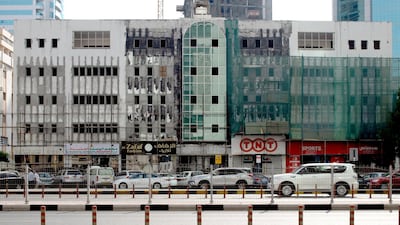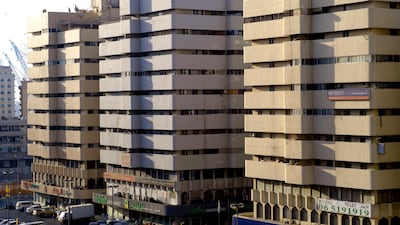For the past two years, Sultan Sooud Al Qassemi has posted images of buildings in Sharjah on his popular Instagram account – ordinary residential types, the kind you pass by without noticing. He generally lists the address, name and date of a building and the architect's name. On some, he simply asks for more information.
For many, this would seem like an after-work hobby – an appreciation of the local city and a desire to find out more about it. But for Al Qassemi, a writer and thinker who has never been content to remain amateur, there were suspicions that this project was something more. And today, in an exclusive with The National, he reveals he is midway through a major architecture research project focusing on the 1960s through to the 1980s. It will culminate in the book Building Sharjah, to be released in 2020.
Life beyond 'starchitects'
“I am looking at what happens in the decades after the discovery of oil here in Sharjah, and the time of the union,” the Sharjah-born Emirati says. “Sharjah was a leading city when it came to architecture, even though we don’t have “starchitects”.
“I want to show people that there was a history between the arish houses and the glass towers.” The arish houses are those built by the Bedouin, using mangrove stalks and split-palm trunks.
_____________
The National editorial: Architecture tells us about our history and ourselves
_____________
Many of these buildings were built by Arab, South Asian and European architects, reflecting the nationalities of the city’s residents and its history as a Trucial State. Realised mostly in white or sand-coloured concrete, they feature the uncluttered geometric grids beloved of Modernism and that movement’s sense of symmetry and balance. Responding to the local climate, a number of them have balconies; others, like a cantilevered building on King Faisal Road (now home to a Choithrams), have unadorned arches, but in general Islamic elements are rare. “From the 1960s to the ’80s, the city’s architecture changed from being free and experimental to having certain guidelines and trying to achieve Islamic architecture trends,” Al Qassemi explains.
Galvanising preservation and uncovering names
Building Sharjah is working to celebrate this under-studied era – and to help galvanise the preservation of the history. A number of these buildings are being torn down or renovated beyond all recognition.
For example, the original Sharjah Post Office building, erected in 1978, was a mastery of sinuous Modernist lines and attenuated arches, but it was covered at some point by a faux-Islamic exterior of stucco arches. When I visited Al Qassemi’s office, in a surprisingly un-Modernist room of yellow floral wallpaper in a converted residential apartment, he had just that morning received a phone call confirming the name of the original architect – information that he’d been chasing for more than two years.
The biographical details behind most of these architects are not accessible by Google. Instead, Al Qassemi, working with Reem Khorshid, Todd Reisz, Noura Al Mahmoud and Ammar Al Attar, has been scouring libraries and speaking to residents, calling architects and getting biographies from their children, in order to gain the information. Al Attar, the photo editor, is a well-respected artist in his own right, and this publication builds upon archival work he has done in his recent project.
At times, the images reflect the way this history has remained, so far, unofficial. The team investigated a building designed by Ali Bek Nassar, an architect from a high-ranking family in Egypt: once an elegant amalgam of arches and rectangular forms, it is now in a state of disrepair. In one early picture of the building, it only appears by chance – in the background of a snapshot of two boys taken by their mother, Prema Babu, on the roof of the very building where Al Qassemi’s offices now sit. The Babus moved into the building on the day it opened, Al Qassemi tells me, and lived in flat number 43 for 38 years, until this March.
Al Qassemi’s own offices tell part of Sharjah’s history. As a member of the emirate’s ruling family, his father was given the land in 1978, and commissioned the Saud building. With that now also in poor shape, the family’s board wishes to tear it down, but Al Qassemi is adamant that it be restored, even if this makes, he admits, little financial sense. Indeed, Al Qassemi refers to the project overall as his “social responsibility”, adding to a number of recent projects tending to the cultural history of his native emirate. Al Qassemi recently gave his extensive collection of Arab Modernism, administered by the Barjeel Art Foundation, to the Sharjah Art Museum, on long-term loan.
How Sharjah's place in history influenced its skyline
Sharjah’s history from the 1960s to 1980s also opens onto the wider role of the region. Sharjah, like the other emirates, benefited architecturally from the UAE being part of the Non-Aligned Movement, or the countries that sided neither with the US nor the USSR during the Cold War. Among them, they developed an architectural style that captured a kind of utopian optimism: often expressed in residential complexes for middle-income housing, and referring, via Modernism’s architectural motifs, to the social ideals of that movement.
This history is being actively explored at the moment by other projects alongside Building Sharjah. The architectural historian Yasser Elsheshtawy has focused on Gulf urbanism, and led a research project for the UAE pavilion at the 2016 Venice Biennale for architecture on the UAE's first wave of social housing. This year's Venice pavilion, curated by Khaled Alawadi, looked at street-level, walkable urban neighbourhoods in Abu Dhabi and Dubai from the era before the "bigness" of glass towers. The new Sharjah Architecture Triennial, which will hold its first event in 2019, will also research the history of urbanism and architecture in the UAE, among other aims. And the Sharjah Art Foundation is now preserving historical landmarks, such as the Flying Saucer from 1978.
Al Qassemi suggests that the appreciation of Sharjah’s architectural history should be taken even further, moving beyond the realm of research and towards proactive measures. “In the UK, there are laws about listing and renovating buildings,” he says. “We also need a law to preserve modern architecture. After 40 years, it should go to a committee.”
At the moment, though, it is a race against time for many of these buildings: not only is the architecture disappearing, but so are the images and oral histories behind them.
_________________________
Read more:
Editorial: Architecture tells us about our history and ourselves
A love letter to Sharjah's many charms
Listen: The UAE arts scene with Sultan Sooud Al Qassemi
The influential female voices shaping the UAE art scene
_________________________









